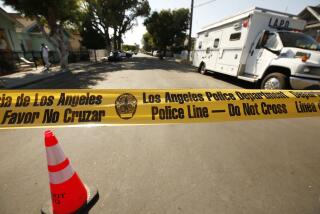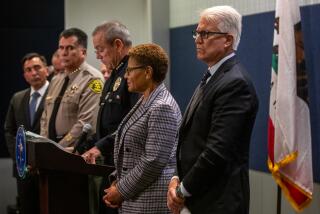More Links in London Bomb Plots Seen
- Share via
LONDON — The emergence of suspected links between last week’s attempted transit bombings and the deadly July 7 blasts here make it increasingly likely that a single terrorist network directing multiethnic, British-based cells was behind both plots, officials said Sunday.
As the investigation continued, police Sunday announced the arrest of a man in a working-class area of South London, where authorities have conducted a manhunt for the four fugitives whose backpack bombs failed to fully detonate on three trains and a bus Thursday. Few details were given about the suspect, who was held under anti-terrorism legislation along with two men arrested Friday. Police have not said if any of the three are among the four fugitive would-be bombers.
South London is an area with large populations of Africans and Afro-Caribs, and is one of several longtime bastions of Islamic extremism in Britain. One of the detainees is said to be of Ethiopian descent. One of the fugitive suspects, who was identified partly through evidence found in an unexploded backpack bomb, apparently has family ties to another African country, according to a senior European police official working with British investigators.
In the July 7 bombings that killed 52 people, three of the attackers were Pakistani-Britons from the northern city of Leeds, and one was a Jamaican convert to Islam living in Luton, north of London.
The targets, methodology and bombs used in both cases were very similar, investigators say. Now, detectives are investigating evidence found in the unexploded backpack bombs that may place members of both cells at the same rafting center in Wales last month, according to officials and news reports.
“The evidence in the backpacks has given good leads,” the European police official said. “Everything seems to connect the two cases.”
Four weeks before they died, two of the July 7 suicide bombers went on a rafting trip in the Tryweryn River wilderness.
Mohamed Sidique Khan, 30, and Shahzad Tanweer, 22, were part of a six-person group that took a two-hour “extravaganza” rafting tour June 4, said Paul O’Sullivan, director of the National Whitewater Center in North Wales.
A photo of the two future bombers wearing helmets and bulky wetsuits and wielding oars, their raft on churning surf, appeared in a British tabloid last week. In the shot, Khan, the suspected leader of the bombers, smiles and flashes a victory sign with his right hand.
Police have questioned employees of the center, known in Welsh as Canolfan Tryweryn, about Khan and Tanweer. The center has provided police with a list of other participants, O’Sullivan said.
Using documents found in the backpack bombs Thursday, detectives have identified suspects and are investigating whether one or more of them crossed paths with Khan and Tanweer at the rafting center, officials said.
O’Sullivan said media inquiries after Thursday’s failed attacks prompted a more thorough search of the roster of participants. The names of a second group of rafters who went on a trip hours after Khan and Tanweer were forwarded to police, O’Sullivan added.
O’Sullivan said neither group struck their guides as unusual. “There’s nothing that stood out,” he said.
The center serves 25,000 rafters a year and is one of Britain’s premiere venues for canoeing and rafting. O’Sullivan said he found it difficult to believe that anyone interested in the clean fun of a river excursion would take part in the indiscriminate massacre of commuters a month later.
“You don’t associate the two things,” he said. “I don’t know how the mind of a suicide bomber is going to work, but to think that you’re going to do something as exciting as this before something like that -- it’s a surprise.”
If the rafting center turns out to have been a point of convergence, it could mean that members of the two cells met in a remote locale to finalize plans for a two-pronged terrorist offensive in London. Or it could mean they took a last recreational trip together before their deadly embrace of “martyrdom.”
In past terrorism cases in Europe and the Middle East, attackers have participated together in martial arts, outdoor sports or, as in the case of the Sept. 11 hijackers in the United States, strength-building at health clubs. They saw the activities as a source of physical training and psychological discipline.
In other developments Sunday, London Metropolitan Police Commissioner Ian Blair apologized in a televised interview for the death of Jean Charles de Menezes, a Brazilian immigrant who was shot to death Friday on a subway train by anti-terrorism officers who mistook him for a suicide bomber after following him from a house under surveillance.
Despite criticism of the shooting, however, police said the dire threat facing London left them no choice but to persist in a policy of opening fire on suspects viewed as imminent suicide bombers.
The arrest of the third suspect Saturday afternoon took place at the same low-income housing complex where De Menezes lived in the Tulse Hill neighborhood. Police had targeted the collection of well-kept brick town homes and apartment buildings for surveillance based on evidence from Thursday’s attempted attacks.
With a mix of awe, fear and indignation, neighbors described Sunday how the raid began: A fleet of about eight BMW sedans carrying an elite anti-terrorism squad led a caravan of well-armed police raiders roaring down the curved driveway past a playground to the main entrance.
The police shouted at neighbors to take cover as they charged into Scotia Street, a short cul-de-sac, witnesses said. Neighbors said they heard as many as 12 detonations that they believed were gunshots.
“They were yelling, ‘Get inside, get inside,’ ” said Joshua Romans, a soft-spoken 17-year-old with braided hair who lives a few doors away from the residence that was raided. “About five or 10 minutes after, there were five shots. After that there was another three, then four. About 12 shots altogether.”
Police said nothing publicly about any gunfire. In previous raids they have detonated tear-gas canisters as they entered buildings. Neighbors said they knew nothing about the suspect who was taken away as white-suited forensic teams hunted for any trace of the would-be bombers.
*
Times staff writer John Daniszewski contributed to this report.
More to Read
Sign up for Essential California
The most important California stories and recommendations in your inbox every morning.
You may occasionally receive promotional content from the Los Angeles Times.










